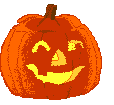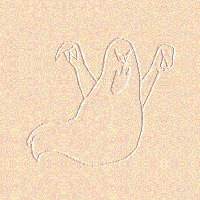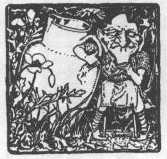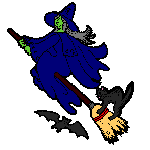



 |
 |
 |
 |
| Halloween-Samhain : Saints, Souls, Sinners by Dorian B |
| The name Halloween refers to the evening of October 31—Hallow for holy, and een, just meaning EVE. We talk about HALLOWED ground or holy ground, the same word. But we sometimes think of this feast as Unholy and with good reason. |
|
|
The
Celtic people, who lived more than 2000 years ago are said to have
considered this evening, October 31, to be the spookiest day of the year. "Are said" is all I can say because the Celts did not write anything down. What we know about these ancient Celts, we know from their conquerors the Romans. The Celts called the feast
Samhain, which is the name that Wiccans call it today. |
| Halloween originated with the Celts, who lived in Europe from North of the Alps to the Baltic Sea from 1000BC to 450AD. The Celts of Ireland celebrated a festival in November called Samhain meaning end of summer. It was considered the New Year. Druids predicted events for the year to come. At the close of the harvest. hearth fires were extinguished and then re-lit from a central hilltop bonfire by the Druids. In the evening, evil spirits stalked the earth. Charms and spells had more power on the eve of Samhain. And rituals were performed by the Druids, to please the Lord of the Dead. Halloween, Samhain , was – and is—the third and final of the year’s harvest feasts. The first one is Lammas, Aug. 2, the first gathering of the harvest. The second is the autumn equinox, the time of the harvest at its fullest yield. When the Romans conquered the Celts, the Christian wrote down their history, so what we know of the Celts is filtered through a not completely sympathetic interpreter. (1) These stories contained supernatural creatures. The human and spirit worlds were said to merge on Samhain. People disguised themselves as ghosts and goblins to protect themselves from evil. Food was an offering of respect for the dead who were thought to return home. These traditions continue today. The Celts believed that when people died, they went to a land of eternal youth and happiness' TirnanOg. Thus, the Feast of the Dead. The Celts did not have the concept of heaven and hell that the Christian church later brought into the land. The dead were sometimes believed to be dwelling with the Fairy Folk, who lived in the numerous mounds throughout the Irish and Scottish countryside. Samhain was the new year to the Celts-in the Celtic belief system, turning points, such as the time between one day and the next. The turning of one year into the next were seen as magickal times. The turning of the year was the most potent of these times. This was the time when the "veil between the worlds" was at its thinnest, and the living could communicate with the dead. |
| The Celts' world view did not include demons nor devils. The fairies, however, were often considered hostile and dangerous to humans. They were seen as being resentful of men taking over their lands. On this night, they would sometimes trick humans into becoming lost in the fairy mounds, where they would be trapped forever. |
 |
| After the coming of the Christians to the Celtic lands, certain people saw the fairies as those angels who had sided neither with
God or with Lucifer in their dispute, and thus, were condemned to walk the earth until judgment day. In addition to the fairies, many humans were abroad on this night, causing
mischief. Since this night belonged neither to one year or the other, Celtic folk believed that chaos reigned and the people would engage in all kinds of tricks. This served also as a last outburst for high spirits before the gloom and doom of winter set in. Then Christianity was born. It grew powerful until. in the fourth century after Christ, the Roman Empire Constantine declared it the official religion of the land. The Christian Fathers tried to stamp out all the old religions including the Celtic beliefs. But since the holiday was already there, serious action had to be taken. The Christian church baptized the old Celtic holiday with new names, new games. The Christian holiday of All Saints Day seemed to tail nicely into Samhein. In the 7th century the Christian church actually celebrated All Saint's Day in May! By the ninth century, however, the date had been changed to November 1st. Why? Because the old pagan ways would not be stamped out, and if you can't beat them, join them. The original festival for the pagan Lord of the Dead became a celebration of the Christian dead--at least those lucky enough to make it to heaven and become saints. But the populace went on expecting the arrival of ghosts on Oct. 31st. Another name for All Saint's Day was All Hallows' Eve. This was later shortened to Halloween. In the 10th century the church named Nov. 2nd as All Souls' Day in memory of all dead souls. |
| The witch is a central symbol of Halloween. The name comes from the Saxon wicca, meaning wise one. Witches rode on horseback, or traveled afoot, carrying a broom or a pole to aid in vaulting over streams. |
 |
 |
The
jack-o-lantern is also
prominent. An Irish myth tells of a man named Stingy Jack, who one day invited the Devil to have a drink. He convinced the Devil to change into a sixpence in order to pay for the drink, but instead of paying for the drink he pocketed the sixpence beside a silver cross which prevented the Devil from changing back. Eventually the Devil got his revenge. |
|
The Halloween Mask From earliest times people defended themselves by wearing masks when droughts, famines or other disasters struck. This remains true today the world over, sometimes as victory celebrations or other remonstrances, from Mardi Gras to all manners of celebrations in all corners of the globe. In the olden times, though, people believed that the demons who had brought their disasters upon them would become frightened off by the masks. Even after the festival of Samhain had merged with Halloween, Europeans felt uneasy at this time of the year. Food was stored in preparation for the winter and the house was snug and warm. The cold, envious ghosts were outside, and people who went out after dark often wore masks to keep from being recognized. Until very recently children would dress up as ghosts and goblins to scare the neighbors, but there was no trick or treating. Around 60 years ago people began to offer treats to the costumed children. And sometimes in the United States a few sick people also offer tricks! Like nails in the candy! |
| Some Irish customs: |
|
|
Church Porch Watch: On New Year's Eve, St. Mark's Eve (April 24th), Midsummer's Eve, and Hallowe'en people would sit all night on the church porch. The apparitions of those who would die in the coming year would come and knock at the door. There was a danger of dying and becoming a faire-cloidh (keep watch) or churchyard walker, a guardian of the graveyard until the next person disturbed the service of the dead. On Hallowe'en people nowadays keep a vigil for the dead by lighting a candle in their homes. |
| People light bonfires on Halloween Night. Wood is collected for the bonfire in advance. The
usual purpose is to keep goblins at arm's length. The big British night for bonfires, though, is
Guy Fawkes night --a guy or dummy is built and burned. British and Irish All Soul's Day The Nightmare: In Cheshire and Shropshire England "soulers" wander around the countryside with a hobby horse. Called a "nightmare" it bears the dead away on her back. American All Soul's Day Memorial: Flowers are put on the graves of relatives and prayers are said in the USA. There is a cemetery in Nanticoke, Pa. Called St. Stanislaus, where people still go to light candles on All Souls Night—passing that cemetery you would see the whole thing lit up with candles. ------------------------------------------------------------------------------ Links: The Cotswold Pagan Society: http://www.thewellhead.org.uk/moots/Samhein03.html Issac Bonewits' The Real Origins of Halloween http://www.neopagan.net/Halloween-Origins.html
|
| _______________________________________________________ |
| Select and click to link to each section: |
| Home | Occult, Paranormal | Dorian's Occult Site | Poetry, Haiku | Mysteries | Halloween | |
| _______________________________________________________ |